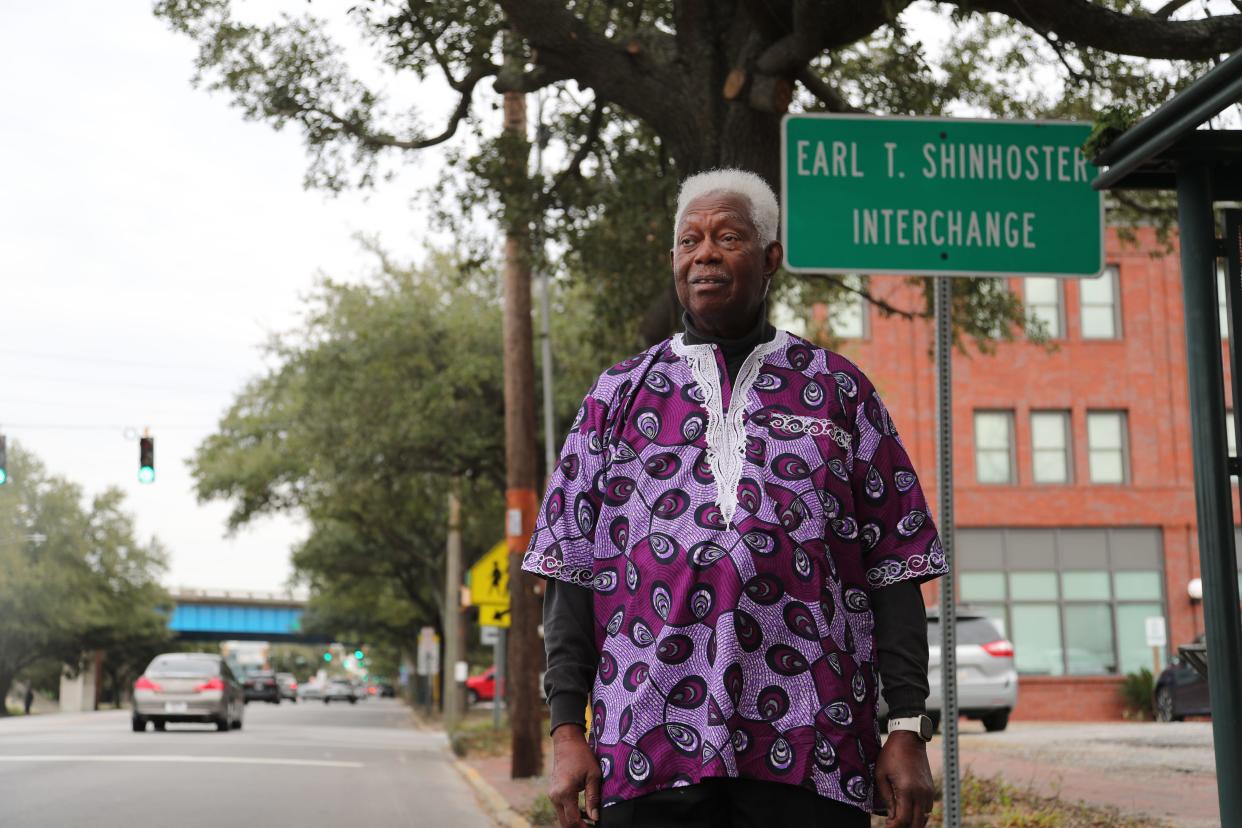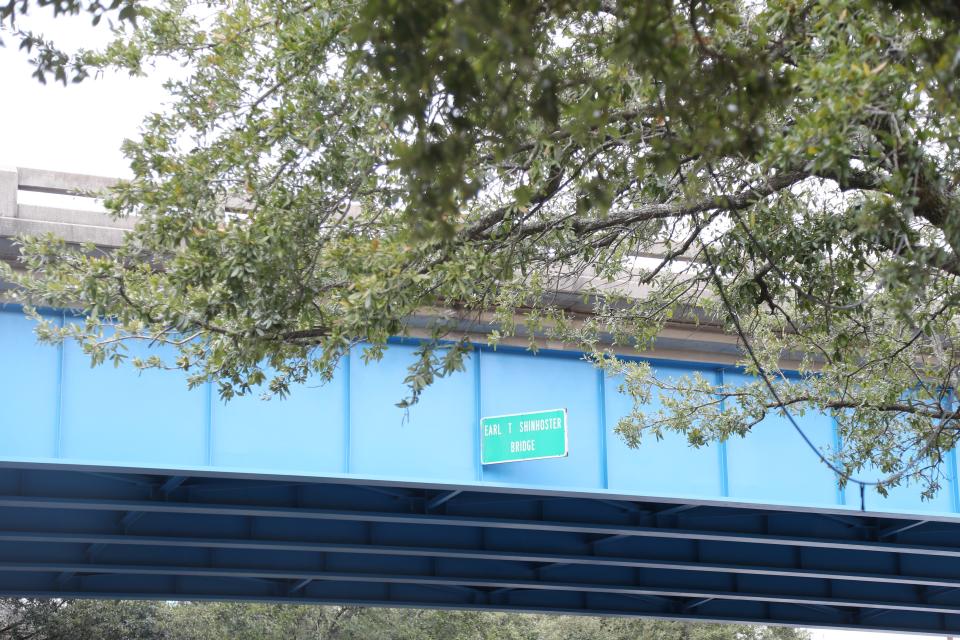With Savannah's I-16 flyover removal in talks, supporters see 'opportunity to recreate community'

- Oops!Something went wrong.Please try again later.
Richard Shinhoster was fresh off graduating from Savannah State in the late 1960s when he and a friend were sitting around talking about Savannah and its needs.
The city didn't have a place to purchase a collection of gospel, jazz, and R&B music, Shinhoster said. The two decided to open up a record shop at 510 W. Broad St., now known as Martin Luther King Jr. Boulevard.
Based on Savannah municipal archives, that would have been right around the time the Interstate-16 flyover opened for use. The record shop was only a block or so from the bridge. Before long, the once thriving Black business corridor saw the number of shop fronts close in droves. By the mid-'70s, Shinhoster's shop was no different and the door was boarded up with wood.
"This flyover is interesting, because we had a thriving business for close to five years," Shinhoster said, "and at that time, West Broad Street began to change because of the highway system."
Rad More: Tightening the Belt: The time has come to rethink how we move through this city
I-16 divided historically Black neighborhoods — Carver Village and Cloverdale among them — on Savannah's westside. The flyover itself tore right through other neighborhoods such as Frogtown, the city's railroad hub. That same bridge went on to be named for Shinhoster's brother, Earl T. Shinhoster, a civil rights activist who had a 31-year career with the NAACP. He was killed in a car accident in 2000.
There were talks of removing the flyover in the 1990s when Richard Shinhoster joined the state-made Savannah Development and Renewal Authority, which sought to revitalize downtown with comprehensive planning and disinvestment after the area's decline.
The demolition of the flyover was a cornerstone of the SDRA's strategic plans. But the wave of efforts from then to now often lacked the city as a strong partner.
That changed in December when Savannah City Council gave the flyover's potential removal a rush of new life when it entered an agreement with the Georgia Department of Transportation to study the flyover's removal.
"I am just delighted to see that they have moved it now to this point," said Shinhoster, who now owns and operates the Diaspora Marketplace in the space where he once sold records. He held onto the space all these years, eventually paying it off. Now, he sells art, clothing and instruments from the African Diaspora.

The agreement, and a little history
The agreement from City Council approved $750,000 for GDOT to conduct a preliminary engineering study known as an Interchange Modification Report, which is a federal requirement for these types of projects.
More: City roundup: Savannah council greenlights study for MLK flyover removal, Kiah House zoning
This future IMR would not be the first in the project's history. One was completed and sent to the Savannah-Chatham County Metropolitan Planning Commission December 2015, but the report expired after GDOT declined to send it to the U.S. Department of Transportation.
That was due to a lack of a project framework agreement between the city and GDOT, which would have established a local funding partner, according to previous reporting by the Savannah Morning News.
But now the city and council have blessed the money for GDOT, which came with a $180,000 local match.
"I think symbolically it shows that this council cares about the future of the MLK-Montgomery corridor," said Bridget Lidy, Savannah's director of planning, zoning and urban design.
More: City Talk: City Council ramps up the long drive toward the removal of the I-16 flyover
But an appetite among those in the city for the flyover's removal is nothing new. The 2015 IMR report states that a series of studies from the SDRA in 1998, 2002, 2004 and 2009 demonstrated the project's feasibility. The report also points to a GDOT analysis in 2008, and a planning study for the local Reclaiming Old West Broad Street group as recently as 2012.
The project's advocates point to increasing connectivity and tapping into what would be approximately eight acres of developable land to spur economic activity if the flyover was removed. The GDOT study from 2008 laid out three potential roadway updates, and each one included restoring grid connections on West Charlton, West Jones and Berrien streets.
"Removing the flyover will allow Savannah, and provide an opportunity, to recreate community," Shinhoster said.
Next steps and future goals
What is next for the city is decision on a $1.8 million federal grant request the city would use to create an equitable redevelopment plan, conceptual designs and conduct community outreach. Lidy said the support from the federal grant would accelerate the process.
In the agenda item on December's council action, the city signaled a community engagement process would identify needs for affordable housing, businesses and civic spaces for the area. The item specifically notes connecting communities to the Canal District and Enmarket Arena.
"I think it's a really unique opportunity to reconnect the historic grid network from the Oglethorpe Plan, and create new connections for these neighborhoods, these communities that are close to downtown and the Canal District," Lidy said.
District 1 Alderwoman Bernetta Lanier, who represents much of the impacted area west of Martin Luther King Jr. Boulevard, remembers being front row at the early community meetings about removing the flyover, she said. Lanier voted in favor of designating the money to GDOT for the IMR report.
Important to her support moving forward, however, is having the right communities at the table during the public engagement process. Some of the neighborhoods Lanier represents along I-16 include Cloverdale and Carver Village.
The negative impacts of urban renewal, of which I-16 is an example, make communities in the area weary of new urban development, Lanier said. Any development in the future should center those residents' concerns.
"We do not want to stop this project; we got to be a part of it," Lanier said.
If the flyover were to be removed, that also means Earl T. Shinhoster's name would come down with the bridge, which was the only major piece of property named for an African American in Savannah, Richard Shinhoster said. But that has not stopped Richard Shinhoster from supporting the flyover's removal.
What the city decides to do with the space through its public engagement could include Earl T. Shinhoster's name, Richard Shinhoster said. His idea? A large greenspace named for his late brother.
"We want to keep that as part of the plan," Richard Shinhoster said. "As long as it's part of the plan, the family supports it."
This article originally appeared on Savannah Morning News: Savannah I-16 flyover removal, MLK Blvd. redevelopment under consideration

